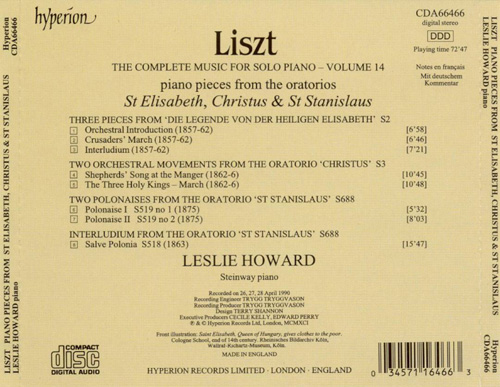
Liszt’s Masses and oratorios were very important to him and were all composed with particular care and subject to intense self-criticism and reworking. The early success of the great orchestral Mass for the Consecration of the Basilika at Esztergom (‘Graner-Messe’) may have encouraged Liszt to complete Die Legende von der heiligen Elisabeth, his first oratorio. The time to complete the work was at hand too, since Liszt had resigned his post at Weimar. Although Liszt refused to attend a production in 1883, the work was quite often given as an opera in the nineteenth century—it is certainly as close as Liszt ever came to completing an opera in his maturity: the work is organized rather like a set-number opera with solos, choruses and orchestral pieces, but bound together by a series of themes and their transformations. These themes, which Liszt quotes in the preface to the full score, act as leitmotifs in the drama
The first, which dominates the orchestral introduction and recurs in some form whenever Saint Elizabeth herself is involved, is a plainchant, ‘Quasi stella matutina’, copied for Liszt by Mihály Mosonyi from an old Hungarian ecclesiastical hymnal. The second, ‘On the Life of St Elizabeth’, which is heard at the beginning of the ‘Interludium’, is from the seventeenth-century collection Lyra coelestis of György Naray. The third, which is a Hungarian popular song given to Liszt by the violinist Reményi, appears in the central martial section of the ‘Interludium’. The Saxon hymn ‘Schönster Herr Jesu’ is used as the lyrical melody in the ‘Crusaders’ March’, while the fifth, a plainchant-derived group of three ascending notes (G, A, C) forms the basis of the main theme of that march, and is, in fact, the so-called ‘Cross-motif’ which recurs throughout Liszt’s religious music, from the Esztergom Mass to the Via Crucis. The vocal score (which also used to be printed by Novello with a Liszt-approved English text) was prepared by Liszt himself.
More notes of Leslie Howard
6.2.22
FRANZ LISZT : Christus & St Elisabeth (Leslie Howard) (1998) FLAC (image+.cue), lossless
Assinar:
Postar comentários (Atom)
+ last month
AVISHAI COHEN — After the Big Rain (2007) FLAC (tracks), lossless
Avishai Cohen's After the Big Rain is an ambitious, earthy and endlessly surprising work that finds the trumpeter/composer melding post-...












https://nitro.download/view/E717F01FDE18914/Franz_Liszt_-_Christus
ResponderExcluir_St_Elisabeth_&_St_Stanislaus.rar